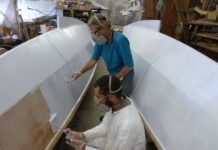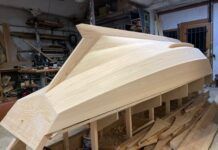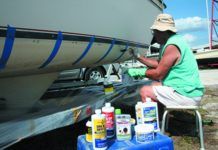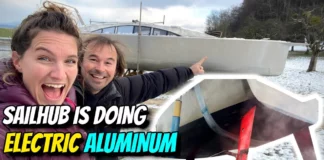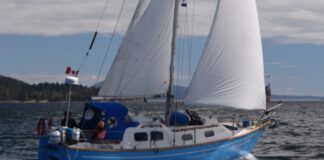Dripless Shaft Seals
Regarding your November 1, 2000 comparison of dripless shaft seals, I have some comments about the PYI/PSS brand (the non-flow version). First off, I agree with all of your comments and reservations about the design.
About two years ago, my wife and I returned to our boat after a night out. We found enough water onboard that had we not owned a trimaran it would have sunk. It turned out that when we had run the engine that morning, the PSS rotor slid down the shaft enough for the seal to release. (At the time, we had no automatic bilge pump, due to our DRY bilges.) Upon further investigation, I found that the set screws had not backed up at all. In fact they were frozen. I had tightened them per instructions with blue Loctite. The set screws had simply not dug into the very hard Aquamet shaft. In spite of using mild heat, penetrants, and days of patience, I could not get the old set screws out. The heads eventually stripped.
The PYI folks were as helpful as they could be, and sent me a reverse drill bit to drill them out. This worked, but ruined the rotor. Then they sent a new rotor and screws (also at no cost).
Next came the job of changing the seal with the boat in the water! I quickly sanded out the scratches on the shaft and installed the new rotor. This went well; problem solved.
I now use a doughnut shaft zinc, just on the engine side of the rotor. I use a small bead of 3M 5200 around the perimeter, and then gently press it into position before tightening its Allen screws.
The key is not to press the rotor out of perpendicular to the shaft with the zinc. Partial contact is good enough.
Removal is quite easy, in spite of the small bead of 5200.
Having installed this safety, I once again have confidence in the PYI shaft seal.
-Mark Johnson
Via e-mail
I installed a Lasdrop shaft seal in my Pelle Petterson Maxi 95 about 20 years ago after the odd, factory-installed Oil Pocket seal (which was somehow similar to the Norscot seal) failed miserably within a year. The Lasdrop worked flawlessly all these years, and the only maintenance I gave it was re-tightening of the hose clamps.
On my present Spindrift 46 cutter I replaced the old stuffing box and now have the non-flow PYI unit, which works just as flawlessly.
I would never have a stuffing box in any boat again.
-Fred Ploetz
San Diego, California
I had a Norscot shaft seal for four years and would not recommend it. The oil seal did a fine job of keeping water from getting in, but it allowed oil to get out. It was very embarrassing to find a few little slicks around my boat every time I docked it. I have now had a PYI/PSS for three seasons and am perfectly satisfied with it.
-Ed Reed
Kennewick, Washington
I disagree with your conclusion that bellows type seals are preferred over lip types because of possible shaft wear from the latter. Moreover, while both systems are basically reliable, I think that lips are far safer. I had a bellows type for about five years but decided to switch three years ago when the bellows started developing a memory and had to be replaced.
Heres my reason for the change to a lip: It is possible (but very unlikely) for a bellows system to fail because the seating piece is under compression from the bellows and clamp and is mechanically attached to a very fast moving and vibrating shaft. If the seating piece moves the result could be disastrous. A lip (and as your article notes, the shaft) can wear, but it is under minimal compression and doesn’t move. It wont fail at once; there would be plenty of warning.
Moreover, I think the shaft wear from a lip will not be a problem even for years to come. The lip creates very little pressure on the shaft, so the wear will be nothing like that from a stuffing box. Thus, unless a sailboat does more motoring than sailing, and in silty water at that, its shaft wear will need a fine micrometer to measure.
-Michael Zelman
Islamorada, Florida
We agree that if the seated piece on the shaft moves away from a bellows seal, youve got a big problem. Thats why we didnt like set screws and really liked the hard rubber clamp. We still stand against on-the-shaft seals because of the hassle in repair. In any case, we thought all of the seals reviewed would yield thousands of hours of service, which is really quite a lot for a sailboat.
Keel Bolt Replacement
Concerning the problem of replacing old keel bolts, I do this on an almost regular basis. I have many boats out there sailing with their original keels after I have replaced up to all their keel bolts.
I used to own a keel-making company called Keelco in Los Angeles. Every now and then we would have to take out a keel bolt and put another in or move the bolts around. Over the 20 years I was in business we changed keel bolts from small keels up to a few of the 12-Meter keel bolts. The cost is far cheaper than replacing the whole keel. The last keel bolts I replaced were on a 6,500-pound keel. The keel bolts cost about $950. The cost to replace that keel from the factory was over $12,000.
In most cases, the keel has to be taken off the boat and then I take out the old keel bolt and weld in another stainless steel keel bolt. I weld a special lead alloy to the main keel lead. I encase the stainless steel bolt back into the keel space that the old bolt was cut out of. If I don’t like how the old bolt was put in then I will improve it. When I weld the new lead to the old keel lead it is a 100% weld, almost like casting it back into the keel. If you took a bolt and just poured lead over the keel bolt and the keel there wouldnt be any strength. Our tests at Keelco showed that we could see as much as a 35% strength gain by using this welding method.
I am taking out the old keel bolt and replacing with a brand new threaded full length 304 stainless steel bolt with a J bend on the bottom. The new bolt will be welded in the lead with a special alloy of lead. I don’t recommend tapping into lead because you have to tap a minimum of 12 inches into the lead and I don’t know how to do that without great difficulty. I am being slightly evasive because this is my business and I don’t want to give out the family secrets.
The main reason that there are a lot of keel bolts that need replacing now is that the standard in the 1970s was to use galvanized steel keel bolts. They are now starting to fail. I am collecting data on what type of boats are starting to have their keel bolts fail and then in the future I plan to put out a warning in some of the yachting magazines as well as on a web site.
I really don’t have a yard because I travel to the boats all over the country. Depending on the type keel I carry about 200 pounds of welding lead and keel bolts to the boat and work on it there.
If any of my welding jobs had failed I would have had them call me. To date no calls. That has been over 19 years.
-Don Huseman
Via e-mail
Paint Stripper
The link below is for a paint stripper that seems to be environmentally safe and is recommended by a reputable distributor in Toronto. Maybe the next time you test strippers you can include this stuff:
http://www.starten.com/index.htm. Ill be trying it on my Pearson 30 as Peel-Away is not available in Canada at a reasonable price – $900 to strip the bottom paint of the Pearson compared to about $200 for the Star Ten.
-Stephen Best
Shelburne, ON, Canada
Where Credit Is Due
To Spectra Watermakers, Sausalito, California and Everfair Enterprises, Punta Gorda, Florida: I want to recognize two outstanding companies that provided us superb technical and warranty support in our first 18 months of live-aboard cruising.
First, Spectra Watermakers for supporting and standing behind their product. Their unit performed exactly as specified for a year, after which we had a slight sticking of the Clark pump. When I called David Smith, he talked me through the (easy) solution and said they would upgrade the pump from our earlier model. In Trinidad, Spectras rep, Echo Marine, did the upgrade, installed a new membrane, and checked the water pump, all at no charge!
Second, Everfair Enterprises, maker of the Four Winds wind generator, for very responsive technical support with Bill Owra talking us through a diagnosis of what turned out to be worn brushes (that I should have changed sooner!) and for sending out new ones the same day we e-mailed them. The fix was easy and the generator is again churning out amps.
Many thanks to both companies!
-Jim Coolbaugh, s/v Asylum

















